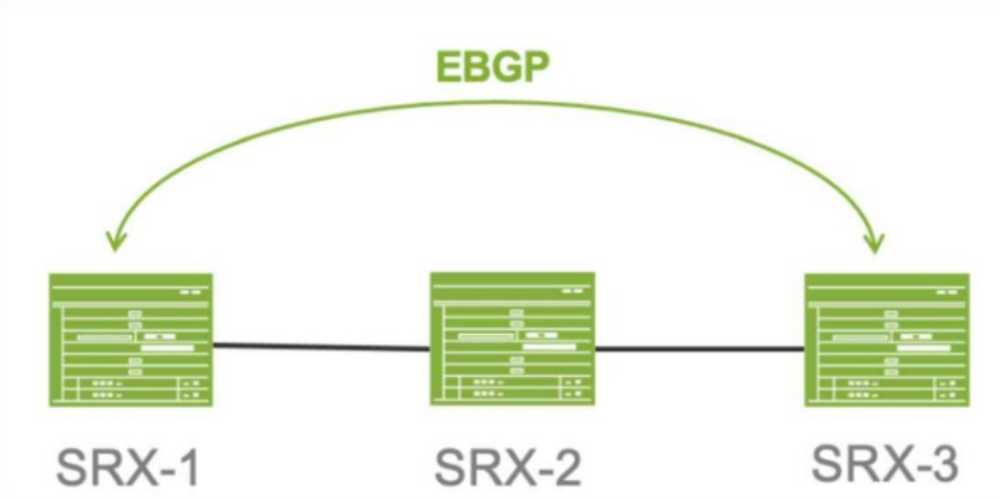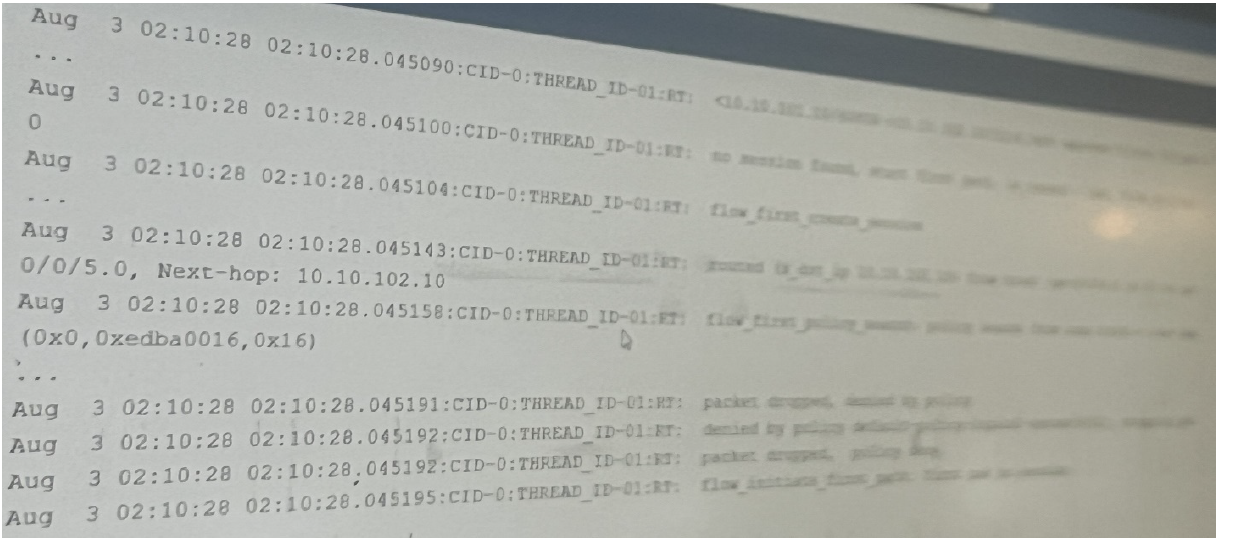Master Juniper Security Professional: Ace Your JN0-637 with Confidence
Click the Exhibit button.

Referring to the exhibit. SRX-1 and SRX-3 have to be connected using EBGP. The BGP configuration on SRX-1 and SRX-3 is verified and correct.
Which configuration on SRX-2 would establish an EBGP connection successfully between SRX-1 and SRX-3?
Correct : D
Comprehensive Detailed Step-by-Step Explanation with All Juniper Security Reference
Understanding the Scenario:
SRX-1 and SRX-3:
Need to establish an EBGP session through SRX-2.
Issue:
BGP session is not coming up despite correct configurations on SRX-1 and SRX-3.
Option D: The security policy to allow SRX-1 and SRX-3 to communicate on TCP port 179 should be configured.
BGP uses TCP port 179 for establishing sessions.
SRX-2 must have a security policy allowing traffic between SRX-1 and SRX-3 on TCP port 179.
'Security policies must permit BGP traffic (TCP port 179) to allow BGP sessions through the SRX device.'
Source: Juniper TechLibrary - Configuring Security Policies for Transit Traffic
Why Other Options Are Incorrect:
Option A: Host-inbound-traffic affects traffic destined to SRX-2, not transit traffic.
Option B and C: TCP ports 79 and 169 are unrelated to BGP.
Conclusion:
The correct option is D, configuring a security policy to allow TCP port 179.
Start a Discussions
You are attempting to ping an interface on your SRX Series device, but the ping is unsuccessful.
What are three reasons for this behavior? (Choose three.)
Correct : A, B, C
A . The interface is not assigned to a security zone.
SRX Series devices rely heavily on security zones for traffic management. If an interface isn't assigned to a zone, the device won't know how to handle traffic arriving on that interface, including ping requests (ICMP echo requests).
B . The interface's host-inbound-traffic security zone configuration does not permit ping.
Even if an interface is in a zone, you must explicitly allow ICMP ping traffic within the zone's host-inbound-traffic settings. By default, most zones block ping for security reasons.
C . The ping traffic is matching a firewall filter.
Firewall filters (configured using the security policies hierarchy) can block specific traffic types, including ICMP. If a filter is applied to the interface or zone, and it doesn't have a rule to permit ping, the ping will be unsuccessful.
Why other options are incorrect:
D . The device has J-Web enabled. J-Web is a web-based management interface and has no direct impact on the device's ability to respond to pings.
E . The interface has multiple logical units configured. Logical units divide a physical interface into multiple virtual interfaces. While this can affect routing and traffic flow, it doesn't inherently prevent ping responses as long as the relevant zones and policies are correctly configured.
Troubleshooting Steps:
If you're unable to ping an SRX interface, here's a systematic approach to troubleshoot:
Verify Interface Status: Ensure the interface is up and operational using show interfaces terse.
Check Zone Assignment: Confirm the interface belongs to a security zone using show security zones.
Examine host-inbound-traffic: Verify that the zone's host-inbound-traffic settings allow ping (e.g., set security zones security-zone trust host-inbound-traffic system-services ping).
Analyze Firewall Filters: Review any firewall filters applied to the interface or zone to ensure they allow ICMP ping traffic. Use show security policies and monitor traffic to diagnose filter behavior.
Test from Different Zones: Try pinging the interface from devices in different zones to isolate potential policy issues.
By systematically checking these aspects, you can identify the root cause and resolve the ping issue on your SRX Series device.
Start a Discussions
You are deploying IPsec VPNs to securely connect several enterprise sites with ospf for dynamic
routing. Some of these sites are secured by third-party devices not running Junos.
Which two statements are true for this deployment? (Choose two.)
Correct : B, C
Understanding the Scenario:
Objective: Deploy IPsec VPNs connecting multiple enterprise sites using OSPF for dynamic routing.
Challenge: Some sites use third-party devices not running Junos OS.
Considerations:
Compatibility between Juniper and third-party devices.
Support for dynamic routing protocols (OSPF) over IPsec VPNs.
Handling overlapping IP address spaces.
Option Analysis:
Option A: OSPF over IPsec can be used for intersite dynamic routing.
OSPF Characteristics:
OSPF uses multicast addresses (224.0.0.5 and 224.0.0.6) for neighbor discovery and routing updates.
IPsec Limitations:
Standard IPsec tunnel mode does not support multicast traffic natively.
Multicast traffic cannot traverse IPsec tunnels unless encapsulated.
Juniper Solution:
Juniper devices can use routed VPNs (route-based VPNs) with st0 interfaces, allowing OSPF over IPsec.
However, this requires support from both ends of the VPN tunnel.
Third-Party Devices:
May not support OSPF over IPsec without additional configurations.
Conclusion:
Option A is not universally true in this scenario due to third-party device limitations.
'OSPF can be run over IPsec VPNs using route-based VPNs, but interoperability with third-party devices must be verified.'
Source: Juniper TechLibrary - OSPF over IPsec VPNs
Option B: Sites with overlapping address spaces can be supported.
Overlapping IP Address Spaces:
Occurs when different sites use the same IP subnets.
Can cause routing ambiguities and conflicts.
Solution:
NAT over VPN:
Use Network Address Translation (NAT) to translate overlapping IP addresses to unique addresses.
Juniper devices support NAT over IPsec VPNs.
Third-Party Device Considerations:
Need to ensure third-party devices support NAT over IPsec.
Many enterprise-grade devices provide this functionality.
Conclusion:
Option B is true; overlapping address spaces can be supported using NAT.
'When sites have overlapping IP addresses, NAT can be used over IPsec VPNs to resolve address conflicts.'
Source: Juniper TechLibrary - NAT with IPsec VPNs
Option C: OSPF over GRE over IPsec is required to enable intersite dynamic routing.
GRE Tunnels:
Generic Routing Encapsulation (GRE) can encapsulate multicast and broadcast traffic.
Allows OSPF packets to be transmitted over IPsec VPNs.
IPsec Encryption:
GRE tunnels can be encrypted using IPsec for secure communication.
Interoperability:
GRE over IPsec is a common method to support OSPF between devices from different vendors.
Third-party devices are more likely to support GRE over IPsec than OSPF over IPsec directly.
Conclusion:
Option C is true; using OSPF over GRE over IPsec is required in this scenario.
'To run OSPF between devices that do not support multicast over IPsec, GRE tunnels can be used over IPsec VPNs.'
Source: Juniper TechLibrary - Configuring GRE over IPsec
Option D: Sites with overlapping address spaces cannot be supported.
Contradicts Option B.
As established, overlapping address spaces can be supported using NAT over IPsec VPNs.
Conclusion:
Option D is false.
Conclusion:
Correct Answers: B and C
Option B: Overlapping address spaces can be supported using NAT over IPsec VPNs.
Option C: OSPF over GRE over IPsec is required to enable intersite dynamic routing, especially when third-party devices are involved.
Additional Detailed
Why OSPF over IPsec May Not Be Feasible (Option A):
Multicast Traffic:
OSPF relies on multicast for neighbor discovery and updates.
IPsec in tunnel mode does not natively support multicast traffic.
Third-Party Devices:
May not support proprietary extensions or configurations required to run OSPF directly over IPsec.
Workaround:
Encapsulate OSPF multicast packets within GRE tunnels, which can carry multicast traffic over unicast IPsec tunnels.
Why OSPF over GRE over IPsec Is Necessary (Option C):
GRE Tunnels:
Encapsulate multicast/broadcast traffic into unicast packets.
Allow routing protocols like OSPF to function over IPsec VPNs.
Compatibility:
GRE is a widely supported protocol across different vendors.
Facilitates interoperability between Juniper and third-party devices.
Supporting Overlapping Address Spaces (Option B):
NAT over IPsec:
Translates private IP addresses to unique addresses across the VPN.
Prevents routing conflicts and allows communication between sites with overlapping subnets.
Considerations:
Requires proper configuration on both ends of the VPN tunnel.
Third-party devices must support NAT over IPsec.
Reference to Juniper Security Concepts:
Route-Based VPNs:
'Route-based VPNs use virtual tunnel interfaces (st0) and support dynamic routing protocols over IPsec.'
Source: Juniper TechLibrary - Route-Based VPNs
GRE over IPsec:
'GRE over IPsec allows the transmission of multicast and non-IP protocols over IPsec tunnels.'
Source: Juniper TechLibrary - GRE over IPsec Overview
NAT with IPsec VPNs:
'NAT can be applied to IPsec VPN traffic to resolve overlapping address issues and facilitate communication between sites.'
Source: Juniper TechLibrary - NAT with IPsec
Final Notes:
Interoperability:
When working with third-party devices, always verify compatibility for protocols and features.
Best Practices:
Use GRE over IPsec for dynamic routing protocols requiring multicast support across IPsec VPNs.
Implement NAT over VPN when dealing with overlapping address spaces.
Start a Discussions
Exhibit:
You have deployed a pair of SRX series devices in a multimode HA environment. You need to enable IPsec encryption on the interchassis link.
Referring to the exhibit, which three steps are required to enable ICL encryption? (Choose three.)
Correct : A, C, D
A . Install the Junos IKE package on both nodes. While I previously stated that IKE is usually included in the base Junos OS image, it's essential to ensure that the necessary IKE package is indeed installed and enabled on both SRX nodes to support ICL encryption.
C . Configure a VPN profile for the HA traffic and apply it to both nodes. This dedicated VPN profile defines the security parameters (encryption algorithms, authentication, etc.) specifically for the ICL traffic.
D . Enable HA link encryption in the IPsec profile on both nodes. Within the IPsec profile, you must explicitly enable ICL encryption to ensure that all traffic traversing the interchassis link is protected.
Why E is incorrect:
E . Enable HA link encryption in the IKE profile on both nodes. While securing IKE negotiations is important, it's typically handled within the IPsec profile itself when configuring ICL encryption on SRX devices.
Start a Discussions
Exhibit:

Which two statements are correct about the output shown in the exhibit. (Choose Two)
Correct : A, C
Start a Discussions
Total 115 questions